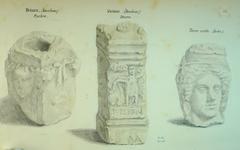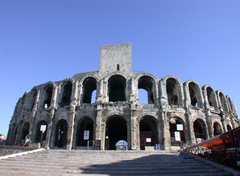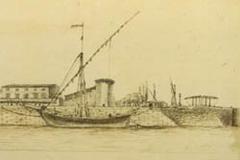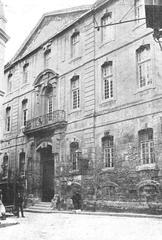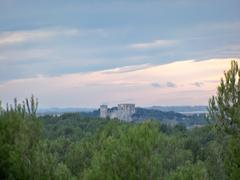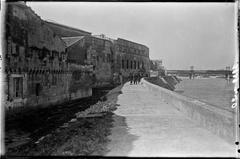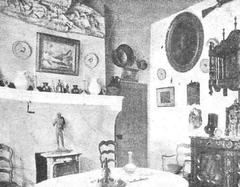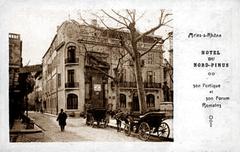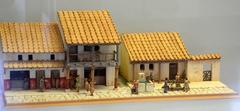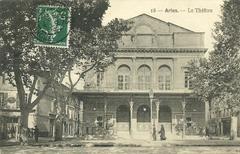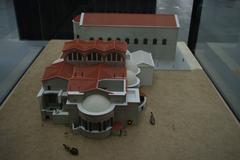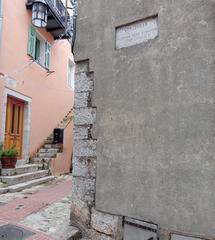Comprehensive Guide to Visiting Arles, Bouches-du-Rhône, France
Date: 13/08/2024
Captivating Introduction
Bienvenue to Arles, Bouches-du-Rhône, France—a captivating city where history and art meld seamlessly. Picture this: walking through ancient Roman ruins, tracing the brushstrokes of Vincent van Gogh, and savoring the rich flavors of Provençal cuisine. This is not just another tourist destination; it’s a living, breathing canvas of cultural heritage and artistic inspiration. Nestled in the heart of Provence-Alpes-Côte d’Azur, Arles has been a melting pot of cultures since around 800 BC. From its early days as a Ligurian and Celtic settlement to becoming a bustling Phoenician trading port, Arles has always been at the crossroads of history (Wikipedia).
Arles truly hit its stride during the Roman Empire, becoming the region’s second most important city after Marseille. Imagine walking through grandiose structures like the Amphitheatre, which could seat over 20,000 spectators and still hosts events today, or the Roman Theatre, a hub for ancient dramas and modern performances (France This Way). But Arles is not just about its Roman past. The city was a vibrant entry point for North African immigrants in the 17th and 18th centuries and even inspired Vincent van Gogh to create over 300 works during his stay here from 1888 to 1889.
In Arles, every corner whispers secrets from the past, and every stone tells a story. Whether you’re a history buff, an art enthusiast, or a foodie, Arles promises a rich and immersive experience. Ready to uncover the secrets of this enchanting city? Let’s dive deep into its history, culture, and hidden gems (Arles Guide).
Table of Contents
- Historical Overview
- Cultural Significance
- Visitor Tips
- Best Time to Visit
- Getting There
- Accommodation
- Safety
- Local Transportation
- Key Attractions: Where History Meets Art
- Festivals and Events
- Dining and Local Cuisine
- Shopping
- Practical Tips
- Nearby Attractions
- Local Secrets and Hidden Gems
- Sensory Descriptions
- Interactive Elements
- Cultural Context and Etiquette
- FAQ
- Call to Action
Historical Overview
Ancient Era
Arles has been a melting pot of cultures since around 800 BC. First inhabited by the Ligurians and later influenced by the Celts, this city was once a bustling Phoenician trading port known as Theline. Fast forward to 46 BC, and you’ll find Arles—then Arelate—rubbing shoulders with Julius Caesar himself. The city earned its stripes as a Roman center after backing Caesar in his feud with Pompey. Talk about picking the right side! (Wikipedia).
Roman Period
Arles hit the jackpot during the Roman Empire, becoming the region’s second most important city after Marseille. The Amphitheatre, a colossal arena from the 1st century AD, could seat over 20,000 spectators and still hosts events like bullfights and plays. The Roman Theatre has seen it all, from ancient dramas to modern performances. The Thermes de Constantin offers a glimpse into Roman luxury (France This Way).
Medieval to Modern Times
The fall of the Roman Empire saw Arles facing invasions from Visigoths, Barbarians, and Saracens. By the 12th century, Arles had cleaned up its act and even became the capital of the Kingdom of Arles under Rudolf II. Fast forward to 1239, and Arles was absorbed into Provence, eventually becoming a vibrant entry point for North African immigrants in the 17th and 18th centuries (Arles Guide).
Artistic Legacy
Arles and Vincent van Gogh? A match made in artistic heaven! Van Gogh spent a prolific year here from 1888 to 1889, creating over 300 works, including “Starry Night Over the Rhone.” The Van Gogh walking trail is a meticulously curated path that takes visitors to the exact spots where Van Gogh set up his easel (Cultured Voyages).
Cultural Significance
Roman Heritage
Arles is a city steeped in Roman history, with its roots tracing back to the 1st century BC when it became a significant commerce center for the Roman Empire. The Roman Amphitheatre, also known as the Arènes d’Arles, could accommodate up to 20,000 spectators and was used for gladiatorial contests and public spectacles. Today, it hosts bullfights and other cultural events (The Provence Guide).
Another significant Roman site is the Roman Theatre, constructed in the late 1st century BC. This theatre once held 10,000 spectators and was a hub for dramatic performances (Fearless Female Travels).
Van Gogh’s Legacy
Arles is famously known as the city that inspired Vincent Van Gogh. The artist moved to Arles in 1888 and produced over 300 paintings and drawings during his stay. The Van Gogh walking trail includes 11 painting sites, such as the Café Van Gogh and the location of the “Starry Night Over the Rhone” painting (Cultured Voyages).
The Fondation Vincent Van Gogh Arles is another must-visit for art enthusiasts. This contemporary art space pays homage to Van Gogh’s legacy while also showcasing works by other modern artists (Perfectly Provence).
Medieval and Renaissance Influences
Arles also boasts a wealth of medieval and Renaissance architecture. The Church of Saint Trophime, with its spectacular carved portal and double-decker cloister, is a prime example of Romanesque architecture (The Good Life France).
The Renaissance period also left its mark on Arles, with several fine mansions built during the 17th century. Walking through the old streets of Arles, visitors can admire the harmonious blend of architectural styles from different periods (Perfectly Provence).
Festivals and Events
Arles celebrates its cultural heritage through various festivals and events. The Rencontres d’Arles, an annual photography festival held from early July through September, attracts photographers and fans from around the world. The Feria du Riz, held in early September, is a tribute to the rice harvest and the bulls from the Camargue region (Perfectly Provence).
Modern Cultural Spaces
Arles is also home to modern cultural spaces like LUMA Arles. This contemporary art complex features a sprawling park with exhibition spaces, including The Tower designed by Frank Gehry (Fearless Female Travels).
Local Traditions and Cuisine
Arles is a city where traditions are deeply rooted in everyday life. The Arlesian women, known for their traditional costumes, are a significant part of the local culture (Perfectly Provence).
The local cuisine is another aspect of Arles’ cultural significance. Provençal dishes, characterized by their use of fresh, local ingredients, are a culinary delight. Visitors can enjoy traditional dishes like ratatouille, bouillabaisse, and tapenade at the city’s numerous cafes and restaurants (Fearless Female Travels).
Visitor Tips
Best Time to Visit
The optimal times to visit Arles for pleasant weather are from April 9th to July 15th and from August 13th to October 28th. During these periods, the average temperatures and humidity levels are ideal for outdoor activities and sightseeing (Champion Traveler). Spring (March through May) offers moderate temperatures, making it a popular time for tourists. Summer (June through August) is the busiest season, perfect for enjoying the city’s festivals and outdoor events (Champion Traveler).
Getting There
Arles is conveniently located in Provence, making it easily accessible by train. The train from Marseille to Arles takes approximately 45 minutes to 1 hour and costs around €32 round trip. From Avignon, the journey takes about 30 minutes and costs around €17 round trip (The Travel Folk).
Accommodation
Arles offers a range of accommodation options to suit different budgets. For luxury stays, consider Hôtel Jules César Arles, which combines modern amenities with historical charm. Mid-range options include Hôtel Le Calendal, known for its excellent location and spa facilities. Budget travelers can opt for places like Hôtel Acacias (PlanetWare).
Safety
Arles is generally safe for tourists, but it’s advisable to exercise a high degree of caution due to travel warnings for France as of December 2023 (Champion Traveler).
Local Transportation
Arles is best explored on foot, especially the historic center with its narrow pedestrian streets and tree-lined public squares. For longer distances, consider renting a car through services like Discover Cars (The Travel Folk).
Key Attractions: Where History Meets Art
Roman Amphitheater (Les Arènes d’Arles)
The UNESCO-listed Roman Amphitheater, dating back to the 1st century CE, is one of the largest and best-preserved ancient monuments in Arles. It could accommodate around 21,000 spectators and is still used today for bullfights, gladiator reenactments, and concerts (PlanetWare).
Van Gogh Self-Guided Walking Tour
Follow in the footsteps of Vincent van Gogh by visiting the sites where he created some of his most famous works. The Van Gogh Pedestrian Path includes 11 painting sites, such as the Café Van Gogh and the location of the “Starry Night Over the Rhone” painting (PlanetWare).
Musée Réattu
This museum, housed in a 15th-century Hospitaller priory, features contemporary art and works by Picasso. It’s a must-visit for art lovers and offers a unique blend of historical and modern art (Lonely Planet).
Festivals and Events
Arles hosts several notable festivals throughout the year. The International Photography Festival runs from July to September, showcasing works from renowned photographers. The Harp Festival takes place at the end of October, and the Epic Film Festival in August features outdoor screenings of Hollywood epics at the Roman Theater (TripSavvy).
Dining and Local Cuisine
Arles offers a variety of dining options, from traditional Provençal cuisine to modern gastronomic experiences. Don’t miss trying local specialties like the bull of Camargue, often prepared in a dish called gardiane, and the olive oil from Baux de Provence. For a unique dining experience, visit the Café Van Gogh, which inspired Van Gogh’s painting “Café Terrace at Night” (France Voyage).
Shopping
For souvenirs and local products, visit the markets in Arles, which are vibrant and full of local produce, crafts, and antiques. The Saturday market is particularly popular and offers a wide range of items, from fresh produce to handmade crafts (Lonely Planet).
Practical Tips
- Language: French is the official language, but English is widely understood in tourist areas.
- Currency: The Euro (€) is the official currency. Credit cards are widely accepted, but it’s advisable to carry some cash for small purchases.
- Electricity: The standard voltage is 230V, and the frequency is 50Hz. Type C and E plugs are used.
- Emergency Numbers: Dial 112 for emergencies, which is the European emergency number.
Nearby Attractions
Arles is a great base for exploring the surrounding region. The medieval city of Avignon, with its UNESCO-listed Palais de Papes, is just an hour away by train. The ancient Roman ruins of Orange and the picturesque villages of the Haut-Vaucluse area are also within easy reach (PlanetWare).
Local Secrets and Hidden Gems
For a secret slice of heaven, visit the Alyscamps – a lesser-known Roman necropolis that’s perfect for a peaceful stroll. And for a quirky custom, don’t be surprised to see locals playing pétanque in the public squares – feel free to join in!
Sensory Descriptions
Feel the cool breeze as you walk through the ancient streets, hear the distant chatter of market vendors, and smell the rich aroma of freshly baked bread wafting from local boulangeries. Arles is a feast for the senses.
Interactive Elements
Challenge: Find the hidden graffiti of Van Gogh near the Rhone River and snap a photo!
Cultural Context and Etiquette
In Arles, it’s perfectly normal to greet shopkeepers with a hearty “Bonjour!” – and don’t forget to make eye contact, it’s considered polite.
FAQ
- Q: What’s the best way to get around Arles?
- A: Walking is your best bet – the city’s historic center is perfect for a leisurely stroll.
- Q: What local dish should I try?
- A: Gardiane, a hearty bull stew – it’s a local favorite!
Call to Action
Ready to uncover the secrets of Arles? Download Audiala, your ultimate audio guide companion, and let the city’s stories come alive in your ears. Explore with expert insights and make your trip unforgettable.
Arles is a city where history, art, and culture converge, offering a rich and immersive experience for visitors. Whether you’re exploring ancient Roman ruins, following in the footsteps of Van Gogh, or enjoying the local cuisine, Arles promises a memorable journey through time and culture.
References
- Wikipedia. (n.d.). Arles. Retrieved from Wikipedia
- France This Way. (n.d.). Roman Arles. Retrieved from France This Way
- Arles Guide. (n.d.). Arles History. Retrieved from Arles Guide
- Perfectly Provence. (n.d.). Arles History. Retrieved from Perfectly Provence





